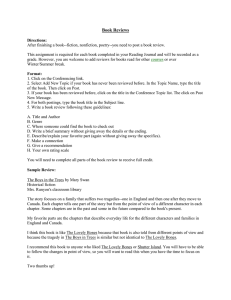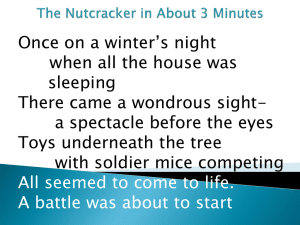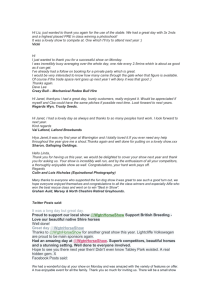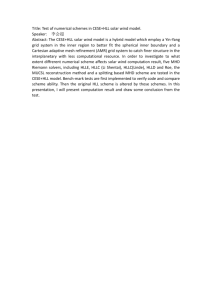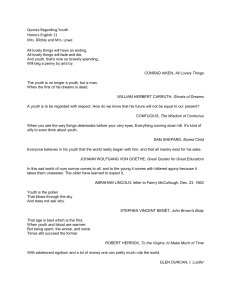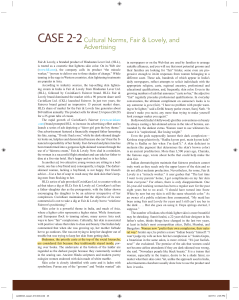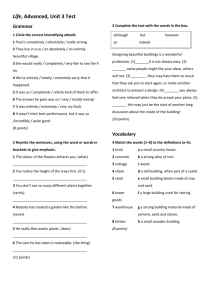CASE 2-2 Fair & Lovely, Advertising
advertisement
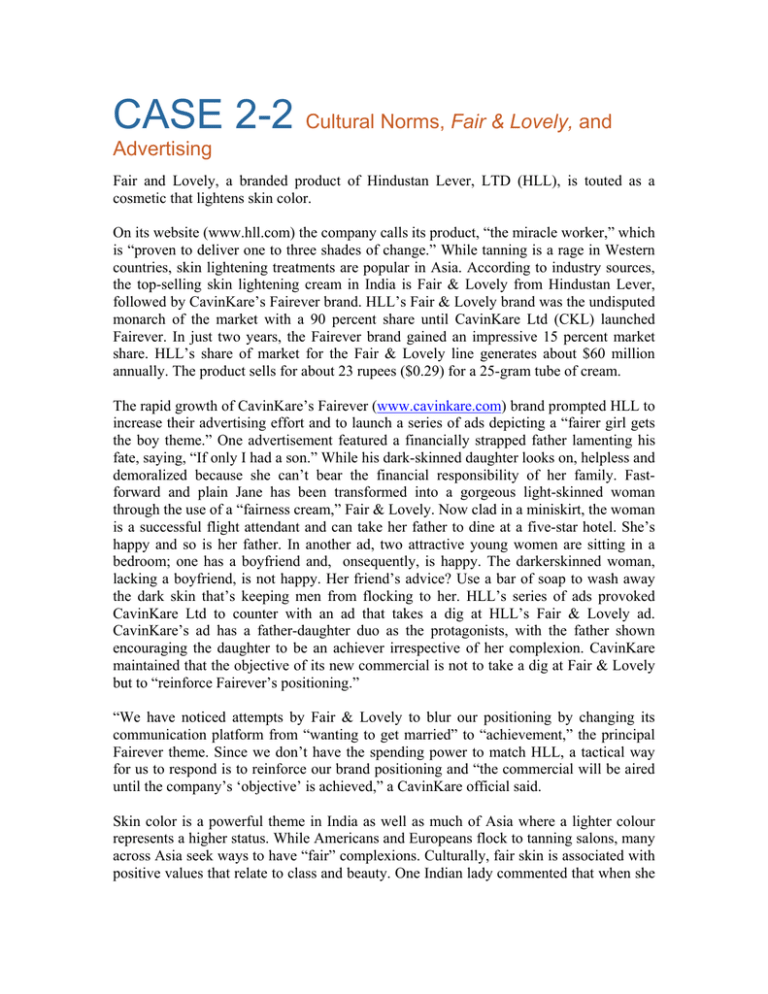
CASE 2-2 Cultural Norms, Fair & Lovely, and Advertising Fair and Lovely, a branded product of Hindustan Lever, LTD (HLL), is touted as a cosmetic that lightens skin color. On its website (www.hll.com) the company calls its product, “the miracle worker,” which is “proven to deliver one to three shades of change.” While tanning is a rage in Western countries, skin lightening treatments are popular in Asia. According to industry sources, the top-selling skin lightening cream in India is Fair & Lovely from Hindustan Lever, followed by CavinKare’s Fairever brand. HLL’s Fair & Lovely brand was the undisputed monarch of the market with a 90 percent share until CavinKare Ltd (CKL) launched Fairever. In just two years, the Fairever brand gained an impressive 15 percent market share. HLL’s share of market for the Fair & Lovely line generates about $60 million annually. The product sells for about 23 rupees ($0.29) for a 25-gram tube of cream. The rapid growth of CavinKare’s Fairever (www.cavinkare.com) brand prompted HLL to increase their advertising effort and to launch a series of ads depicting a “fairer girl gets the boy theme.” One advertisement featured a financially strapped father lamenting his fate, saying, “If only I had a son.” While his dark-skinned daughter looks on, helpless and demoralized because she can’t bear the financial responsibility of her family. Fastforward and plain Jane has been transformed into a gorgeous light-skinned woman through the use of a “fairness cream,” Fair & Lovely. Now clad in a miniskirt, the woman is a successful flight attendant and can take her father to dine at a five-star hotel. She’s happy and so is her father. In another ad, two attractive young women are sitting in a bedroom; one has a boyfriend and, onsequently, is happy. The darkerskinned woman, lacking a boyfriend, is not happy. Her friend’s advice? Use a bar of soap to wash away the dark skin that’s keeping men from flocking to her. HLL’s series of ads provoked CavinKare Ltd to counter with an ad that takes a dig at HLL’s Fair & Lovely ad. CavinKare’s ad has a father-daughter duo as the protagonists, with the father shown encouraging the daughter to be an achiever irrespective of her complexion. CavinKare maintained that the objective of its new commercial is not to take a dig at Fair & Lovely but to “reinforce Fairever’s positioning.” “We have noticed attempts by Fair & Lovely to blur our positioning by changing its communication platform from “wanting to get married” to “achievement,” the principal Fairever theme. Since we don’t have the spending power to match HLL, a tactical way for us to respond is to reinforce our brand positioning and “the commercial will be aired until the company’s ‘objective’ is achieved,” a CavinKare official said. Skin color is a powerful theme in India as well as much of Asia where a lighter colour represents a higher status. While Americans and Europeans flock to tanning salons, many across Asia seek ways to have “fair” complexions. Culturally, fair skin is associated with positive values that relate to class and beauty. One Indian lady commented that when she was growing up, her mother forbade her to go outdoors. She was not trying to keep her daughter out of trouble but was trying to keep her skin from getting dark. Brahmins, the priestly caste at the top of the social hierarchy, are considered fair because they traditionally stayed inside, poring over books. The under-caste at the bottom of the ladder are regarded as the darkest people because they customarily worked in the searing sun. Ancient Hindu scriptures and modern poetry eulogize women endowed with skin made out of white marble. Skin colour is closely identified with caste and is laden with symbolism. Pursue any of the “grooms” and “brides wanted” ads in newspapers or on the web that families use to arrange suitable alliances and you will see that most potential grooms and their families are looking for “fair” brides; some are progressive enough to invite responses from women belonging to a different caste. These ads, hundreds of which appear in India’s daily newspapers, reflect attempts to solicit individuals with the appropriate religion, caste, regional ancestry, professional and educational qualifications, and frequently, skin colour. Even in the growing numbers of ads that announce “caste no bar,” the adjective “fair” regularly precedes professional qualifications. Bollywood (India’s Hollywood) glorifies conventions on beauty by always casting a fairskinned actress in the role of heroine, surrounded by darkest extras. Women want to use whiteners because it is “aspirational,” like losing weight. Even the gods supposedly lament their dark complexion— Krishna sings plaintively, “Radha kyoon gori, main kyoon kala? (Why is Radha so fair when I’m dark?)”—a skin deficient in melanin (the pigment that determines the skin’s brown colour) is an ancient predilection. More than 3,500 years ago, Charaka, the famous sage, wrote about herbs that could help make the skin fair. Indian dermatologists maintain that fairness products cannot truly work as they only reach the upper layers of the skin and so do not affect melanin production. Nevertheless, “hope springs eternal” and for some Fair & Lovely is a “miracle worker.” “The last time I went to my parents’ home, I got compliments on my fair skin from everyone,” one user gushes. But for others, only disappointment. One 26-year-old working woman has been a regular user for the past eight years but to no avail. “I should have turned into Snow White by now but my skin is still the same wheatish colour.” The number of Indians of the opinion that lighter skin is more beautiful may be shrinking. Sumit Isralni, a 22-year-old hair designer in his father’s salon, thinks things have changed in the last two years, at least in India’s most cosmopolitan cities, Delhi, Mumbai and Bangalore. Women now “prefer their own complexion, their natural way” Isralni says; he prefers a more “Indian beauty” himself. “I won’t judge my wife on how fair her complexion is.” Sunita Gupta, a beautician in the same salon, is more critical. “It’s just foolishness!” she exclaimed. The premise of the ads that women could not become airline attendants if they are dark skinned was wrong, she said. “Nowadays people like black beauty.” It is a truism that women, especially in the tropics, desire to be a shade fairer no matter what their skin colour. Although, unlike the approach used in India, advertisements elsewhere usually show how to use the product and how it works. HLL launched their television ad campaign to promote Fair & Lovely in December 2001 and withdrew it in February 2003, amid severe criticism for its portrayal of women. Activists argued that one of the messages the company sends through its “air hostess” demonstrating the preference for a son who would be able to take on the financial responsibility for his parents—is especially harmful in a country such as India where gender discrimination is rampant. Another offense is perpetuating a culture of discrimination in a society where “fair” is synonymous with “beautiful.” AIDWA (All India Democratic Women’s Association) lodged a complaint in March and April 2002 with HLL about their offensive ads but Hindustan Lever failed to respond. The women’s association then appealed to the National Human Rights Commission alleging that the ad demeaned women. AIDWA objected to three things: (1) the ads were racist, (2) they were promoting son preference, and (3) they were insulting to working women. “The way they portrayed the young woman who, after using Fair & Lovely, became attractive and therefore lands a job suggested that the main qualification for a woman to get a job is the way she looks.” The Human Rights Commission passed AIDWA’s complaints on to the Ministry of Information and Broadcasting which said the campaign violated the Cable and Television Networks Act of 1995—provisions in the Act state that no advertisement shall be permitted which “derides any race, caste, colour, creed and nationality” and that “Women must not be portrayed in a manner that emphasized passive, submissive qualities and encourages them to play a subordinate secondary role in the family and society.” The government issued notices of the complaints to HLL. After a year-long campaign led by the AIDWA, Hindustan Lever Limited discontinued two of its television advertisements for Fair & Lovely fairness cold cream in March 2003. Shortly after pulling its ads off the air, and, coincidently, on International Women’s Day, HLL launched its “Fair & Lovely Foundation,” vowing to “encourage economic empowerment of women across India” by providing resources in education and business. Millions of women “who, though immensely talented and capable, need a guiding hand to help them take the leap forward.” Presumably into a fairer future. HLL sponsored career fairs in over 20 cities across the country offering counselling in as many as 110 careers. It supported 100 rural scholarships for women students passing their tenth grade, a professional course for aspiring beauticians, and a three-month Home Healthcare Nursing Assistant’s course catering to young women between the ages 18 and 30. According to HLL, The Fair & Lovely Academy for Home Care Nursing Assistants offers a unique training opportunity for young women who possess no entry level skills and, therefore, are not employable in the new economy job market. Fair & Lovely Foundation plans to serve as a catalyst for the economic empowerment for women across India. The Fair & Lovely Foundation will showcase the achievements of these women not only to honour them, but also to set an example for several other women to follow. Here are a few facts about HLL taken from www.hll.com. Lever Limited is India’s largest Packaged Mass Consumption Goods Company. We are leaders in Home and Personal Care Products and Food and Beverages including such products as Ponds and Pepsodent. We seek to “meet everyday needs to people everywhere— to anticipate the aspirations of our consumers and customers and to respond creatively and competitively with branded products and services which raise the quality of life.” It is this purpose which inspires us to build brands. Over the past 70 years, we have introduced about 110 brands. Fair & Lovely has been specially designed and proven to deliver one to three shades of change in most people. Also its sunscreen system is specially optimized for Indian skin. Indian skin unlike Caucasian skin tends to ‘tan’ rather than ‘burn’ and, hence, requires a different combination of UVA & UVB sunscreens. The fairness cream is marketed in over 38 countries through HLL Exports and local Unilever companies and is the largest selling skin lightening cream in the world. The brand today offers a substantive range of products to consumers including Fair & Lovely Fairness Reviving Lotion, Fair & Lovely Fairness Cold Cream and Fair & Lovely Fairness Soap. Some information on CavinKare taken from www.cavinkare.com: “We shall achieve growth by continuously offering unique products and services that would give customers utmost satisfaction and thereby be a role model.” Goal In fifteen years (2012) we will be a hundred times our current turnover. Values and Beliefs of CavinKare Integrity The Company values honesty and truthfulness above everything else in all its interactions. Our thoughts, words and actions shall be the same. We shall try our utmost to fulfil promises and honour commitments. Fairness The company shall be fair in all its dealings with people inside and outside. We will follow rules, norms and procedures not only in letter but in spirit as well; we will show common decency in all our dealings with people; we will not exploit undue advantages; we will respect the rights of others. Excellence The company values highly all efforts that lead to high standards in everyday work and results. We shall attempt to be the best-in-class in anything we choose to work on. We shall encourage any individual or collective effort in promoting excellence. Innovation The company values innovative thinking, innovative approaches and innovative solutions in our regular work life. We will always look for better ways of doing things; we will seek new ideas to solve problems; we will experiment with new concepts, ideas and solutions. Openness The company believes that openness to new ideas, thoughts and opinions makes relationships stronger and productive, we shall listen to others; we shall openly discuss among colleagues all that are appropriate; we shall welcome ideas from everywhere. Trust The company believes that trust is an important ingredient for effective functioning within the organization and with the outside world. While we shall protect our legitimate business interests, we would also approach the people, issues and associations with straightforwardness, optimism and positive outlook. Stretch The company believes that people have infinite potential. We have an extraordinary capability to exert and extend the limits of the possible. We shall aim for stretch goals, ambitious targets and ever-receding horizons. QUESTIONS For Case Study 2.2: Evaluate the ethical problems linked to Fair & Lovely advertising and recommend potential marketing strategies to overcome these, simultaneously considering the strengths and weaknesses of the brand. Included within the answer should be: demonstrating adequate understanding of basic concepts in strategy formulation, implementation and review; evidencing skills of holistic analysis of the case in defining and identifying brand vulnerability in the context of brand imagery (brand associations); and identifying and elaborating appropriate alternative marketing strategies that are both feasible and credible. Sources: Nicole Leistikow, “Indian Women Criticize ‘Fair & Lovely’ Ideal,” Women’s eNews, April 28, 2003; Shuchi Sinha, “Skin Care: Fair & Growing,” India Today, December 4, 2000, p. 48; Ratna Bhushan, “CavinKare Changes Tack to Challenge HLL Strategy,” Business Line (The Hindu), July 10, 2002; Arundhati Parmar, “Objections to Indian Ad Not Taken Lightly,” Marketing News, June 9, 2003, p. 4; “Fair & Lovely Launches Foundation to Promote Economic Empowerment of Women,” Press Release, Fair & Lovely Foundation (www.hll.com and search for foundation), March 11, 2003; Cavinkare Changes Tack to Challenge HLL Strategy,” Indian Business Insight, July 10, 2002; Shunu Sen, “A Fair Way of Advertising,” Business Line (The Hindu), August 1, 2002; “Ad Nauseam,” The Statesman-Asia Africa Intelligence Wire, March 9, 2002; Rina Chandran, “All For Self-Control,” Business Line (The Hindu), April 24, 2003; Miriam Jordan, “Creams for a Lighter Skin Capture the Asian Market, Especially in India, as a Cultural Virtue,” International Herald Tribune, May 24, 1998; Simon Robinson and Peter Hawthorne, “Color Blindness: Obsessed with Fair Skin, Many African Women Are Using Dangerous Lighteners,” Time, July 30, 2001; Khozem Merchant and Edward Luce, “Not So Fair and Lovely,” Financial Times, March 19, 2003; and Bhanu Pande and Seema Shukla, “Big Brother Is Watching,” The Economic Times, May 9, 2003. Bibliography Cateora−Graham: International Marketing, 12th Edition. VI. Supplementary Material 2−2. Cultural Norms, Fair & Lovely, and Advertising. McGraw−Hill Companies, 2004
